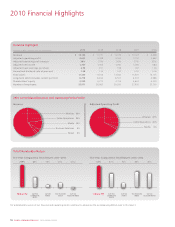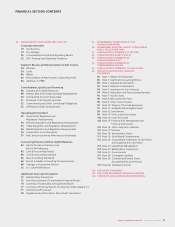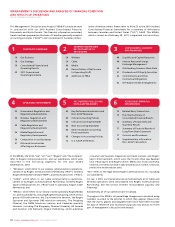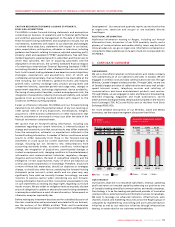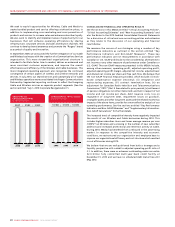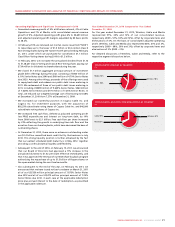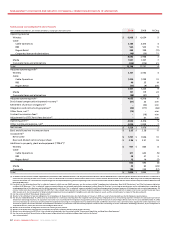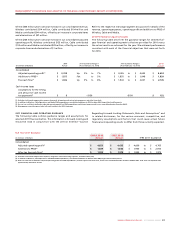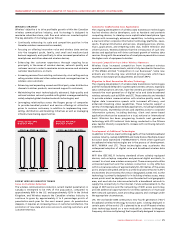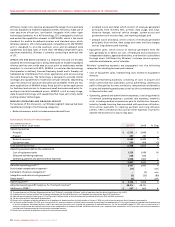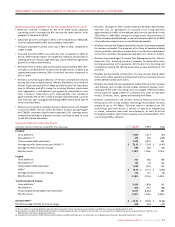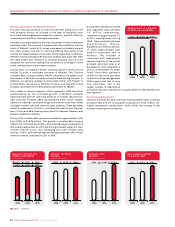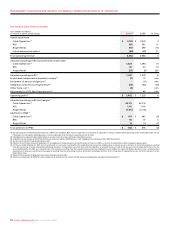Rogers 2010 Annual Report Download - page 22
Download and view the complete annual report
Please find page 22 of the 2010 Rogers annual report below. You can navigate through the pages in the report by either clicking on the pages listed below, or by using the keyword search tool below to find specific information within the annual report.
MANAGEMENT’S DISCUSSION AND ANALYSIS OF FINANCIAL CONDITION AND RESULTS OF OPERATIONS
26 ROGERS COMMUNICATIONS INC. 2010 ANNUAL REPORT
efficiency, lower costs, improve and expand the range of voice and data
services available via mobile broadband wireless networks, make use of
new spectrum allocations, and better integrate with other open
technology standards. As a 4G technology, LTE is designed to build on
and evolve the capabilities inherent in UMTS/HSPA, which is the world
standard for mobile broadband wireless and standard upon which
Wireless operates. LTE is fully backwards compatible with UMTS/HSPA
and is designed to provide seamless voice and broadband data
capabilities and data rates of more than 100 Mbps (dependent upon
spectrum availability). Wireless is currently conducting a technical trial
of LTE.
WiMAX (the IEEE 802.16 standard) is a relatively new and not broadly
adopted 4G technology that is being developed to enable broadband
wireless services over a wide area at a cost point to enable mass market
adoption. In contrast with WiFi, WiMAX is a cellular-like technology
that operates in defined, licenced frequency bands and is thereby not
hampered by interference from other applications and services using
the same frequencies. The technology is designed to provide similar
coverage and capabilities to traditional cellular networks (depending
upon the amount of spectrum allocated and available). There are two
main applications of WiMAX today: fixed (point-to-point) applications
for backhaul and services to homes and small businesses and point-to-
multipoint mobile broadband access. WiMAX is still an early-stage,
data-focused technology with capabilities that have yet to fully match
existing cellular technologies.
WIRELESS OPERATING AND FINANCIAL RESULTS
For purposes of this discussion, our Wireless segment revenue has been
classified according to the following categories:
• Networkrevenue,whichincludesrevenuederivedfrom:
• postpaid(voiceanddata),whichconsistsofrevenuesgenerated
principally from monthly fees, airtime, data usage, and long-
distance charges, optional service charges, system access and
government cost recovery fees, and roaming charges; and
• prepaid(voiceanddata),whichconsistsofrevenuesgenerated
principally from airtime, data usage and other ancillary charges
such as long-distance and roaming.
• Equipment sales, which consist of revenue generated from the
sale, generally at or below our cost, of hardware and accessories to
independent dealers, agents and retailers, and directly to subscribers
through direct fulfillment by Wireless’ customer service groups,
websites and telesales, net of subsidies.
Wireless’ operating expenses are segregated into the following
categories for assessing business performance:
• Costofequipmentsales,representingcostsrelatedtoequipment
revenue;
• Salesandmarketingexpenses,consistingofcoststoacquireand
retain current and new subscribers, such as advertising, commissions
paid to third parties for new activations, remuneration and benefits
to sales and marketing employees as well as direct overheads related
to these activities; and
• Operating,generalandadministrativeexpenses,consistingprimarily
of network operating expenses, customer care expenses, retention
costs, including residual commissions paid to distribution channels,
Industry Canada licencing fees associated with spectrum utilization,
inter-carrier payments to roaming partners and long distance
carriers, CRTC contribution levy and all other expenses incurred to
operate the business on a day-to-day basis.
Summarized Wireless Financial Results
Years ended December 31,
(In millions of dollars, except margin) 2010(1) 2009 %Chg
Operating revenue
Postpaid $ 6,272 $ 5,948 5
Prepaid 297 297 –
Network revenue 6,569 6,245 5
Equipment sales 399 409 (2)
Total operating revenue 6,968 6,654 5
Operating expenses before the undernoted
Cost of equipment sales 1,225 1,059 16
Sales and marketing expenses 628 630 –
Operating, general and administrative expenses 1,948 1,923 1
3,801 3,612 5
Adjusted operating profit(2)(3) 3,167 3,042 4
Stock-based compensation expense(4) (11) – n/m
Settlement of pension obligations(5) –(3) n/m
Integration and restructuring expenses(6) (5) (33) (85)
Other items(7) (5) –n/m
Operating profit(2) $ 3,146 $ 3,006 5
Adjustedoperatingprotmarginas%ofnetworkrevenue(2) 48.2% 48.7%
Additions to PP&E(2) $ 937 $ 865 8
(1) The operating results of Cityfone Telecommunications Inc. (“Cityfone”) are included in Wireless’ results of operations from the date of acquisition on July 9, 2010.
(2) As defined. See the sections entitled “Key Performance Indicators and Non-GAAP Measures” and “Supplementary Information: Non-GAAP Calculations”.
(3) Adjusted operating profit includes losses of $11 million and $13 million related to the Inukshuk wireless broadband initiative for 2010 and 2009, respectively.
(4) See the section entitled “Stock-based Compensation”.
(5) Relates to the settlement of pension obligations for all employees in the pension plans who had retired as of January 1, 2009 as a result of annuity purchases by the Company’s pension plans.
(6) For the year ended December 31, 2010, costs incurred relate to i) severances expenses resulting from the targeted restructuring of our employee base; ii) restructuring expenses resulting from the outsourcing
of certain information technology functions; and iii) the acquisition transaction costs incurred and integration of acquired businesses. For the year ended December 31, 2009, costs incurred relate to i)
severances resulting from the targeted restructuring of our employee base to combine the Cable and Wireless businesses into a communications organization; and ii) severances and restructuring expenses
resulting from the outsourcing of certain information technology functions.
(7) Relates to the resolution of obligations and accruals relating to prior periods.


